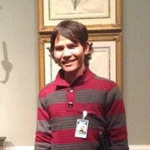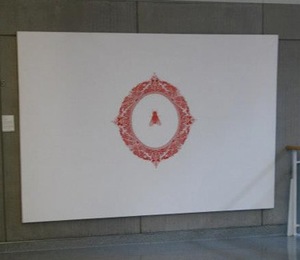Interview: Koshal Hamal | Nepal
 Koshal Kumar Hamal (1988), Nepal
Koshal Kumar Hamal (1988), Nepal
MA in Arts and Design, Beaconhouse University, Lahore, Pakistan
Koshal Hamal, an EAS artist, was recently selected to be included in the World Bank's Imagining Our Future Together contest. To celebrate his success, fellow EAS artist Madeleine Blake recently interviewed Koshal about his work, his thoughts on EAS, and what kind of social role art plays in a globalized world.
MB: Sizing and perspective play an important role in your pieces. Can you explain your choice to present these subjects in such unique spaces?
KH: My interest in the history of visual arts and literature led me to reading many books and questioning history. Looking at an object and re-contextualizing its meaning became a part of my life. I was trying to find the ‘truth’ in artists’ works. I wanted to make a dialogue between artists and their social concerns. I play with semiotics in my works which is why I do not believe in filling the whole canvas with shining colors. I focus on what is more important and significant. Conceptually and culturally, a tiny, framed image in the center of a canvas represents a particular era of a significant history.
MB: Given that we now live in an interconnected, global world, do you think the social role of art has changed recently? Has it become more or less important?
KH: Yes. Since we are dealing with a global world, the social role of art has also changed. Art has become a key medium of communication which mainly deals with the questioning of global themes, rather than creating a specific pure identity of a particular culture or nation. Thus, in order to be more identified in one circle, the role of contemporary art has become more important to unite the globe.
MB: How do you see your art in terms of "crossing borders"?
KH: All of my art practice is about challenging myself. I am always trying to create something that is more significant to contemporary audiences. I do not try to follow conventional rules and regulations in my art. The meaning is all about creating an imagination of the future in my works...
MB: Can you explain a bit how negative space plays into your paintings?
KH: The Imagination! The imagination of future and the study of the past! This idea resulted in my new piece from 2011 called “This is not a Housefly” which was selected to be exhibited at The World Bank in 2012.
MB: Congratulations on your World Bank achievement! What does this achievement mean for you?
KH: Thank you! I think this “congratulations” goes to Samlima Hashmi, Naazish Attaulah, Maureen Korp, Rashid Rana, Quddus Mirza, Ali Raza who were my major influences in my works. The World Bank achievement has given me the wings of social responsibility and a newfound work ethic…The wings I have were awarded by the UNESCO Madanjeet Art Scholarship at Beaconhouse National University which helped me to reach this [international] stage. I am not happy, but more serious, dynamic and playful. It has helped me to connect South Asian countries to the rest of the world. The award I received has helped me to further my art practices.
MB: What is it like being connected to artists from around the world through Emergent Art Space? How has this connection, if at all, changed your idea of the current global art scene?
KH: It’s really helpful that Emergent Art Space has helped young artists to connect with each other from al over the world. It gives us a sense of relational aesthetics. The connection has helped us to understand the identity of other cultures and their work. I hope this will remain a strong platform for young artists in the future!
Check out Koshal's portfolio and his piece in Crossing Borders
Do you want to see an artist on EAS featured? Have you recently had an artistic achievement outside of EAS? Send an email to our Programs Coordinator at laura@emergentartspace.org to let us know!
